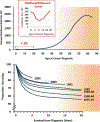Survivors of childhood and adolescent cancer: life-long risks and responsibilities
- PMID: 24304873
- PMCID: PMC6425479
- DOI: 10.1038/nrc3634
Survivors of childhood and adolescent cancer: life-long risks and responsibilities
Abstract
Survival rates for most paediatric cancers have improved at a remarkable pace over the past four decades. In developed countries, cure is now the probable outcome for most children and adolescents who are diagnosed with cancer: their 5-year survival rate approaches 80%. However, the vast majority of these cancer survivors will have at least one chronic health condition by 40 years of age. The burden of responsibility to understand the long-term morbidity and mortality that is associated with currently successful treatments must be borne by many, including the research and health care communities, survivor advocacy groups, and governmental and policy-making entities.
Figures




Similar articles
-
Temporal patterns in the risk of chronic health conditions in survivors of childhood cancer diagnosed 1970-99: a report from the Childhood Cancer Survivor Study cohort.Lancet Oncol. 2018 Dec;19(12):1590-1601. doi: 10.1016/S1470-2045(18)30537-0. Epub 2018 Nov 8. Lancet Oncol. 2018. PMID: 30416076 Free PMC article.
-
Long-term outcomes of adult survivors of childhood cancer.Cancer. 2005 Dec 1;104(11 Suppl):2557-64. doi: 10.1002/cncr.21249. Cancer. 2005. PMID: 16247780
-
The Childhood Cancer Survivor Study: a resource for research of long-term outcomes among adult survivors of childhood cancer.Minn Med. 2005 Apr;88(4):45-9. Minn Med. 2005. PMID: 15942996
-
The long-term survivors.Br Med Bull. 1996 Oct;52(4):898-923. doi: 10.1093/oxfordjournals.bmb.a011590. Br Med Bull. 1996. PMID: 9039739 Review.
-
Long-term survivors of childhood cancers: what knowledge have we gained?Nat Clin Pract Oncol. 2004 Nov;1(1):26-31. doi: 10.1038/ncponc0020. Nat Clin Pract Oncol. 2004. PMID: 16264796 Review.
Cited by
-
Barriers and facilitators to the implementation of a new European eHealth solution (SurPass v2.0): the PanCareSurPass Open Space study.J Cancer Surviv. 2023 Nov 28. doi: 10.1007/s11764-023-01498-8. Online ahead of print. J Cancer Surviv. 2023. PMID: 38015382
-
Effects of Combined Interventions of Physical Activity and Diet in Childhood Cancer Survivors: A Systematic Review.Children (Basel). 2024 Jul 13;11(7):853. doi: 10.3390/children11070853. Children (Basel). 2024. PMID: 39062301 Free PMC article. Review.
-
Increased Cardiac Risk After a Second Malignant Neoplasm Among Childhood Cancer Survivors: A FCCSS Study.JACC CardioOncol. 2023 Oct 3;5(6):792-803. doi: 10.1016/j.jaccao.2023.07.008. eCollection 2023 Dec. JACC CardioOncol. 2023. PMID: 38205003 Free PMC article.
-
A Comparison of Late Mortality Among Survivors of Childhood Cancer in the United States and United Kingdom.J Natl Cancer Inst. 2021 May 4;113(5):562-571. doi: 10.1093/jnci/djaa151. J Natl Cancer Inst. 2021. PMID: 33002115 Free PMC article.
-
Fertility Preservation in Childhood Cancer: Endocrine Activity in Prepubertal Human Testis Xenografts Exposed to a Pubertal Hormone Environment.Cancers (Basel). 2020 Sep 30;12(10):2830. doi: 10.3390/cancers12102830. Cancers (Basel). 2020. PMID: 33008013 Free PMC article.
References
-
- Howlader N et al. (National Cancer Institute, Bethesda, MD: ).
-
- Norris RE & Adamson PC Challenges and opportunities in childhood cancer drug development. Nat Rev Cancer 12, 776–82 (2012). - PubMed
Publication types
MeSH terms
Substances
Grants and funding
LinkOut - more resources
Full Text Sources
Other Literature Sources
Medical
Miscellaneous

